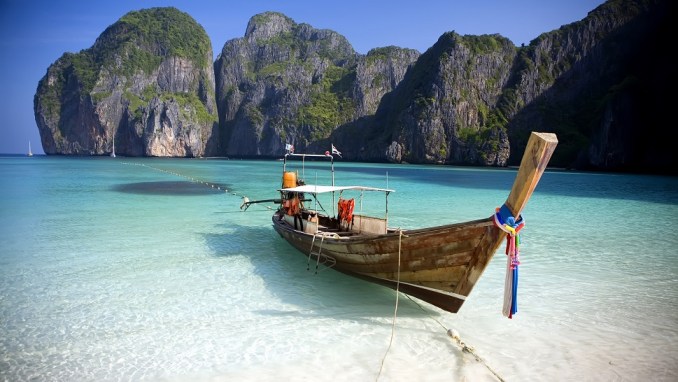With more than fifteen million tourists visiting the country each year, Thailand is Asia’s most popular, diverse and vibrant travel destination. The country offers a myriad of attractions to its visitors: pristine rainforests, spectacular coastal scenery, sun-kissed beaches, floating markets, UNESCO protected ruins, and remote hill tribes. And then there’s Bangkok, Asia’s most exciting city and a sublime destination in its own. Despite being a magnet for budget and backpacker travelers, Thailand also happens to be home to some of the world’s most ultra-luxurious resorts, whether it be beach enclaves, urban hotels or jungle retreats.
Get the most out of your (luxury) trip to Thailand with my travel guide. Find out more about:
- Best time to visit
- How to get there
- Travel requirements
- Getting around
- Inspiration, highlights, & travel tips
- Suggested itineraries
- Recommended luxury hotels (+ reviews)
BEST TIME TO VISIT
Thailand experiences four annual seasons:
- The cool and dry season – which lasts from November to February – is considered the best time to visit Thailand, with plenty of sunshine and day temperatures in the high 70s°F to low 80s°F (26°C-29°C). Sporadic showers may occur in the cool season but are infrequent events.
- The hot and dry season lasts from March to May, with humidity reaching uncomfortable levels and temperatures averaging in the upper 90s Fahrenheit (mid-30s Celsius). Although this period usually remains dry, rains may gather force in the month of May, which is more of a transition period towards the wet season.
- The hot and wet season, which lasts from June to August, is marked by daily heavy downpours, which bring relief for the sticky, humid weather. The days often start sunny, with showers mostly occurring in the (late) afternoon or evening, lasting for 3 to 4 hours.
- The cool and wet season occurs in September and October and sees the return of more comfortable temperatures, although it’s probably the worst time to visit Thailand because the torrential rains are coming to a peak, often bringing floods and making roads impassable. Most days are cloudy and beach conditions are poor. It’s not all bad news since low visitor numbers means great hotel deals.
The best time to visit the kingdom coincides with the northern hemisphere’s winter period, November through February. However, it has the be noted that the weather in Thailand has become less predictable over the past few years as a result of global warming, with the rainy season often starting in April and lasting through all of November. In addition, Thailand is a large country and there are some geographical variations in the seasonal patterns:
- The mountainous, northern part of Thailand (where Chiang Mai is located) is less humid and experiences the greatest variation in temperatures. Throughout the cool and dry season, evenings can be chilly here due to the lack of cloud cover, with temperatures occasionally approaching the freezing level on the higher slopes. However, this region is often hotter than the rest of the country between March and May, when it is not unusual for the mercury to break into the 100s Fahrenheit (upper 30s Celsius).
- The southern, tropical part of Thailand enjoys more consistently warm temperatures throughout the year, with less variation the closer you get to the equator, although there are significant differences in the precipitation in this area:
- The Andaman coast – where the resort areas of Phuket and Krabi are located – experiences the wettest rainy season in all of Thailand, with downpours starting in April and usually persisting until November.
- Conversely, the Gulf Coast and its offshore islands – such as the popular island of Koh Samui – are sheltered from the southwest monsoon by mountains and suffer less from the rainy season than the Andaman coast: Koh Samui’s great weather lasts from about February to September, with the northeast monsoon bringing heavy rains between October and January, especially in November.
For a month to month weather report in Thailand, check this excellent website.
HOW TO GET THERE
Most tourists will arrive in Thailand via one of the following international airports: Suvarnabhumi Airport and Don Mueang Airport near Bangkok, Chiang Mai Airport in northern Thailand, and the airfields that serve the resort areas of Phuket, Krabi and Koh Samui.
- Suvarnabhumi Airport (BKK), also known as (New) Bangkok International Airport, is the main international airport serving Bangkok and one of the biggest international airports in Southeast Asia. Click here for a list of airlines that offer direct flights to Suvarnabhumi Airport.
- Don Mueang International Airport (DMK), also known as (Old) Bangkok International Airport, is the other international airport serving the greater Bangkok area. Don Mueang Airport was closed and replaced by the new Suvarnabhumi Airport in 2006, before reopening in 2007 after renovations. Since the opening of the new airport, it has become a regional commuter flight hub and the de facto low-cost airline hub. Click here for a list of airlines that offer direct flights to Don Mueang international Airport.
- Chiang Mai International Airport (CNX) is the international airport serving Chiang Mai, the capital city of the Chiang Mai Province, and the major gateway to Northern Thailand. Click here for a list of airlines that offer direct flights to Chiang Mai.
- Phuket International Airport (HKT) is an international airport located in the north of Phuket Island, Thailand’s most popular resort destination. Click here for a list of airlines that offer direct flights to Phuket.
- Krabi International Airport (KBV) is the international airport serving Krabi, which is located across the bay from Phuket island. This airport is expanding rapidly with airlines such as Qatar Airways and Finnair now serving the destination. Click here for a list of airlines that offer direct flights to Krabi.
- Samui International Airport (USM), also known as Koh Samui Airport, is an airport that serves the island of Koh Samui. It was built by and is still privately owned by Bangkok Airways, the major airline serving the destination. Click here for a list of airlines that offer direct flights to Koh Samui.
Before you buy a plane ticket, consider reading my tips & tricks for buying the cheapest plane ticket.
TRAVEL REQUIREMENTS
Requirements for entry into Thailand differ from country to country, and are subject to change. Prior to departure, always check with your government and your nearest Thai embassy or consulate what documents you need for travel to Thailand.
- Your passport must be valid for at least six months beyond the date of your entry into Thailand.
- The visa exemption rule allows tourists from 55 countries – including the USA, Canada, Australia, New Zealand and most European countries – to enter Thailand without a visa. They are granted to stay a maximum of 30 days if they are entering Thailand via an international airport or entering through a land border checkpoint from neighboring countries. Nationals from other countries need a visa to enter the country.
Make sure you read my 10 tips to plan a worry-free trip.
GETTING AROUND
Thailand’s domestic transport system is efficient and cheap, albeit not always speedy. Flying is the most convenient way to cover some of Thailand’s large distances, especially when you are on a tight schedule. But if you have the time to take in the countryside, there is the possibility to travel by bus, train, or private car, although long-distance journeys over land in Thailand can be arduous events.
- A domestic flight within Thailand can save you days of traveling: a flight from Chiang Mai to Phuket takes two hours compared to two days over land by a combination of train and bus travel. There are several domestic airlines that serve all of Thailand’s larger cities in addition to the resort towns. There is stiff competition between carriers, meaning that great bargains are often available, especially if you book in advance. Tickets can be booked online via the airlines’ websites:
- Thai Airways (Thailand’s flag carrier, member of the Star Alliance)
- Bangkok Airways (a full service, boutique airline)
- Air Asia Thailand (low-cost carrier)
- Nok Air (budget subsidiary of Thai Airways)
- Orient Thai Airlines (low-cost carrier)
- Thai Smile Airways (low-cost carrier)
- Travel by train in Thailand carries a certain romanticism. The rail network is managed by the State Railway of Thailand (SRT), and consists of four main lines and a few branch lines. The Northern Line, which connects Bangkok with Chiang Mai, is a popular route with tourists and takes about a day (or night) of travel. The railway system also extends all the way to Thailand’s southern border, where it connects with Malaysia’s Keretapi Tanah Melayu Berhad (KTM), with service to Penang, Kuala Lumpur, and Singapore. The SRT runs a number of different trains, each at a different speed, and priced accordingly. First-class sleepers are the trains you want to be booked in, since they usually provide air-conditioned, two-bunk compartments with wash basin.
- Travel by bus is the cheapest and most convenient way of getting around Thailand, especially to the farthest and most remote destinations in the country. They come in several categories, ranging from public or private to air-conditioned or non-air-conditioned buses. Longer bus trips usually depart in the evenings to arrive at their destination early in the morning. Whenever you can, opt for the VIP buses, especially for overnight trips, since these buses feature reclining seats with extra legroom, a toilet, and limited onboard service (e.g. snacks).
- Regular ferries connect all major islands with the mainland, and for the vast majority of crossings you simply buy your ticket on board.
It has to be noted that the safety standards of Thailand’s domestic transport system are suboptimal, and getting around by public transport in the kingdom carries an inherent risk. Safety regulations, when they exist, are hardly ever enforced. Bus accidents are frequent events, especially due to poor maintenance, excessive speed, and exhausted drivers. Also, a small number of ferry sinkings have happened in recent years, so try to avoid traveling on boats that are in poor condition or clearly overloaded. Finally, although traveling by air remains the safest way of transportation within the country, Thailand’s aviation industry has been downgraded in 2015 over safety concerns by the USA’s Federal Aviation Administration (FAA).
INSPIRATION, HIGHLIGHTS, & TRAVEL TIPS
There are several good reasons why you should put Thailand on your bucket list:
- Explore Bangkok, one of Asia’s most fascinating cities, with its floating markets and Grand Palace
- Be wowed by towering limestone cliffs around Phuket island
- Participate in Thai cookery classes in Chiang Mai
- Enjoy a traditional Thai massage
- Hike in the rainforest of Thailand’s northern mountains
- Visit the ancient ruins of Prasat Hin Phimai
- Relax on world-class beaches
- Stay at one the world’s most exclusive resorts: Soneva Kiri
The following, in-depth articles may also inspire you and help you plan your holiday to Thailand:
- Top 10 best things to see & do in Thailand
- Top 10 most fabulous luxury resorts in Thailand
- Top 10 best ultraluxe resorts in Phuket
- Tips & tricks for getting the best deal at a luxury hotel
- Tips & tricks for buying the cheapest plane ticket
SUGGESTED ITINERARIES
It’s impossible to suggest one itinerary for Thailand, but I hereby share with you a two-week schedule based on my own travel experiences in Thailand. Three weeks are recommended though if you have more time and want to travel at a more leisurely pace.
- Days 1-3: explore Bangkok (recommended hotels: Mandarin Oriental Bangkok, St Regis Bangkok, Park Hyatt Bangkok, or The Siam Hotel)
- Days 4-6: explore Chiang Mai & surroundings (recommended hotels: The Dhara Dhevi Chiang Mai or The Four Seasons Resort Chiang Mai)
- Days 7-9: explore the Golden Triangle (recommended hotel: The Four Seasons Tented Camp Golden Triangle)
- Days 10-15: relax on Koh Kood (recommended hotel: Soneva Kiri)
Alternatively, if Soneva Kiri – one of my favorite resorts in the world – is not within your budget range, you can fly to one of the southern resort areas, and stay there for a week of relaxation on sun-kissed beaches (albeit no resort nor beach here comes close to the experience that Soneva Kiri offers):
- Recommended hotel in Phuket: I refer to my top 10 list of the best hotels in Phuket.
- Recommended hotels in Krabi: Rayavadee Krabi, Pimalai Resort & Spa, and Phulay Bay, a Ritz-Calton Reserve
- Recommended hotels in Koh Samui: Four Seasons Resort Koh Samui, Banyan Tree Koh Samui, W Retreat Koh Samui, and Conrad Koh Samui,
For more ideas, I suggest the excellent Thailand itineraries as provided by The Rough Guides and Frommers.
RECOMMENDED LUXURY HOTELS (+ REVIEWS)
Consider visiting my top 10 lists if you are eager to know how I rank Thailand’s top hotels, based on my own experience:
Below, you find my reviews of hotels in Thailand (with pros, cons, and tips to save money per hotel).
 Review of the Waldorf Astoria Bangkok Hotel (Thailand)
Review of the Waldorf Astoria Bangkok Hotel (Thailand) Review: Asia’s largest hotel villa at Soneva Kiri (Thailand)
Review: Asia’s largest hotel villa at Soneva Kiri (Thailand) Review: AMAZING Soneva Kiri (Thailand)
Review: AMAZING Soneva Kiri (Thailand) Review: Four Seasons Tented Camp Golden Triangle (Thailand)
Review: Four Seasons Tented Camp Golden Triangle (Thailand) Review: The Siam, best luxury hotel in Bangkok (Thailand)
Review: The Siam, best luxury hotel in Bangkok (Thailand) Review: Rosewood Phuket (Thailand)
Review: Rosewood Phuket (Thailand) Review: Keemala Phuket Resort & Spa (Thailand)
Review: Keemala Phuket Resort & Spa (Thailand) Review: Banyan Tree Hotel Bangkok (Thailand)
Review: Banyan Tree Hotel Bangkok (Thailand) Review: Park Hyatt Hotel Bangkok (Thailand)
Review: Park Hyatt Hotel Bangkok (Thailand) Review: The Naka Island, a Luxury Collection resort (Phuket)
Review: The Naka Island, a Luxury Collection resort (Phuket) Review of Four Seasons Resort Chiang Mai (Thailand)
Review of Four Seasons Resort Chiang Mai (Thailand) Review of my FAVORITE hotel in the world, Soneva Kiri (Thailand)
Review of my FAVORITE hotel in the world, Soneva Kiri (Thailand) Review: Crown Lanta Resort & Spa, Koh Lanta (Thailand)
Review: Crown Lanta Resort & Spa, Koh Lanta (Thailand) Hotel review: ultraluxe Amanpuri, Phuket (Thailand)
Hotel review: ultraluxe Amanpuri, Phuket (Thailand) Hotel review: Dhara Dhevi Chiang Mai (Thailand)
Hotel review: Dhara Dhevi Chiang Mai (Thailand) Hotel review: COMO Point Yamu, Phuket (Thailand)
Hotel review: COMO Point Yamu, Phuket (Thailand) Review of the ultraluxe Banyan Tree Phuket resort (Thailand)
Review of the ultraluxe Banyan Tree Phuket resort (Thailand) Hotel review: Mandarin Oriental Bangkok (Thailand)
Hotel review: Mandarin Oriental Bangkok (Thailand) Hotel review: Six Senses Yao Noi, Phuket (Thailand)
Hotel review: Six Senses Yao Noi, Phuket (Thailand) Review: Four Seasons Resort Koh Samui (Thailand)
Review: Four Seasons Resort Koh Samui (Thailand) Hotel review: St Regis Bangkok (Thailand)
Hotel review: St Regis Bangkok (Thailand) Hotel review: Banyan Tree Samui (Thailand)
Hotel review: Banyan Tree Samui (Thailand)
*** Follow me on Twitter, Instagram and Facebook for a daily moment of travel inspiration ***



got every thing what i wanted, thank you for sharing this detailed information, it has been a great help.!